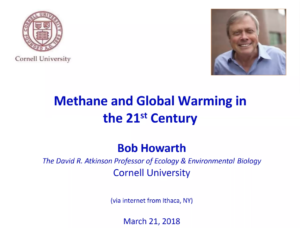 On 21 March Food & Water Europe co-organized a webinar on methane with Robert Howarth, Professor of Ecology & Environmental Biology at Cornell University. Methane is a highly potent greenhouse gas that is closely linked to the extraction and transport of fossil gas.
On 21 March Food & Water Europe co-organized a webinar on methane with Robert Howarth, Professor of Ecology & Environmental Biology at Cornell University. Methane is a highly potent greenhouse gas that is closely linked to the extraction and transport of fossil gas.
[Here is the recording of the webinar, as well as a written summary of the issues discussed and the power point presentation.]
Howarth states that methane emission reductions are crucial if the global community wants to have a chance to stay well below 2 degrees global warming (a temperature rise beyond 2 degrees is more than dangerous for humanity). There has been a clear rise in methane emissions in the past few years: methane emissions from human activity have increased by 170 percent.
The impact of methane on our climate is very high, particularly in the short term: It is a greenhouse gas around 86 times more potent than CO2 on a 20-year time scale. Reducing its emissions drastically would therefore have a significant impact on the climate in the coming years. Nevertheless, it is extremely important to tackle CO2 emissions at the same time since carbon dioxide emitted today will affect our climate for the next thousands of years.
Where Does Methane Come From?
Methane emissions can occur both naturally and from human activities. One big source is methane that has formed over time in rock formations and is the main component of natural gas; another major source is methane that is generated when organic material decomposes in the absence of oxygen. The majority of methane emitted today is being released because of human activities. The main source of human-caused (or anthropogenic) methane in the atmosphere are emissions in connection with oil and gas extraction as well as coal use. Animal agriculture, landfills and sewage, as well as rice cultivation and biomass burning, also contribute to a significant but smaller amount of anthropogenic methane emissions.
Methane From Oil and Gas Extraction
It is difficult to measure methane since it is colorless and odorless, and can happen at any stage of the life-cycle of natural gas. Several studies trying to estimate and measure methane emissions show that the estimated amounts emitted vary widely. However, it also needs to be taken into account that there is a range of industry-influenced studies, and independent data is very limited and poorly documented.
When dealing with methane, the case of shale gas is crucial. During its extraction, high amounts of methane are released and high methane concentrations in the atmosphere have been measured above where it has been extracted. Globally, atmospheric methane increased between 2010 and 2014, which is largely due to emissions from the United States and very likely linked with the shale oil and gas boom. It is estimated that 10 to 12 percent of shale gas production leaks in the form of methane, making this kind of gas extremely dangerous for our climate and far worse than coal or other fossil fuels.
A Dual Measurement Approach
It is important to be aware of how methane is being compared to other greenhouse gases. Currently, the IPCC and most governments and official institutions dealing with greenhouse gases compare CO2 and methane on a 100-year time scale, and outdated numbers are often used. Since methane is a very potent greenhouse gas but only stays in the atmosphere for 12 years, its global warming potential seems a lot lower examining it over a 100-year time span. Using the most recent IPCC numbers, methane emitted today would therefore only be 34 times more potent than CO2 until 2118. On a 20-year time scale, its global warming potential (GWP) would rise to 86, showing that methane is much more of a problem than often suggested.
At the same time, the 100-year time scale needs to be taken into account to properly address the long-lasting effects of CO2 on our climate. Thus, both timeframes should be considered when looking at priorities to reduce greenhouse gases. During the COP23 in Bonn, a coalition called “Put Climate On Pause” was formed that calls for the use of this dual measurement system.
Food & Water Europe and Food & Water Watch are members of this coalition and along with other members, we campaign for a use of both the 20-year and the 100-year time frame.
The most realistic way of effectively reducing CO2 and methane emissions is to swiftly move to a 100 percent renewable energy system. And a dual measurement system helps us show how drastic the greenhouse gas reductions will need be.


